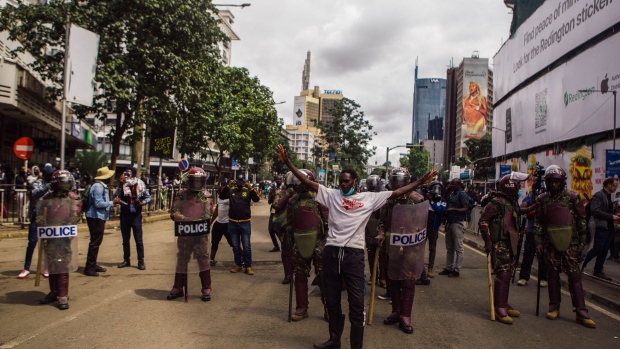Jun 28, 2024
Kenya Prepares Spending Cuts After Scrapping $2.3 Billion Taxes
, Bloomberg News

(Bloomberg) -- Kenya is preparing to implement spending cuts after deadly protests forced President William Ruto to back down on plans to raise $2.3 billion in new taxes.
A supplementary budget for the year beginning July 1 is expected to be presented to lawmakers after parliament resumes sitting in about four weeks. The head of parliament signaled on Thursday the shortfall that’s expected to be created by the abandoned tax plans will be funded through spending cuts.
“We are guided that the financing gap may be bridged by the reduction of approved expenditure,” National Assembly Speaker Moses Wetang’ula said in a statement.
Ruto has been pushing for tax increases and other measures to reduce the country’s reliance on borrowing, in line with fiscal reforms agreed with the International Monetary Fund three years ago. The National Treasury had targeted higher taxes to slash its fiscal deficit to 3.3% of gross domestic product in the year through June 2025, from an estimated 5.7% in the current period.
The president made a U-turn on the taxes after police fired on the protesters in the capital, Nairobi, and other areas of Kenya, killing at least 23 people. He committed to slashing expenditure on non-priority areas including travel, hospitality, the purchase of motor vehicles, refurbishing offices, and so-called confidential spending by security agencies.
Lawmakers are currently on recess and are scheduled to resume house sittings on July 23 to approve Ruto’s recommendations to delete all clauses in the contentious bill. The proposed levies included a 16% value added tax on bread and the introduction of a so-called eco duty on diapers, sanitary pads and wheelchair wheels.
The government planned to spend 3.99 trillion shillings ($31 billion) in the budget year starting July and the new tax measures that have now been abandoned would have raised 302 billion shillings.
With Ruto’s withdrawal of the taxes, Kenya will likely miss its fiscal targets, according to according to Morgan Stanley strategist Neville Mandimika.
The government may cut capital expenditure and county government transfers to offset the shortfall, according to Mark Bohlund, a senior credit research analyst at REDD Intelligence.
“With the government already facing challenges to finance itself at the current high interest rates, both domestic and in international markets, the government has little leeway,” he said.
©2024 Bloomberg L.P.






